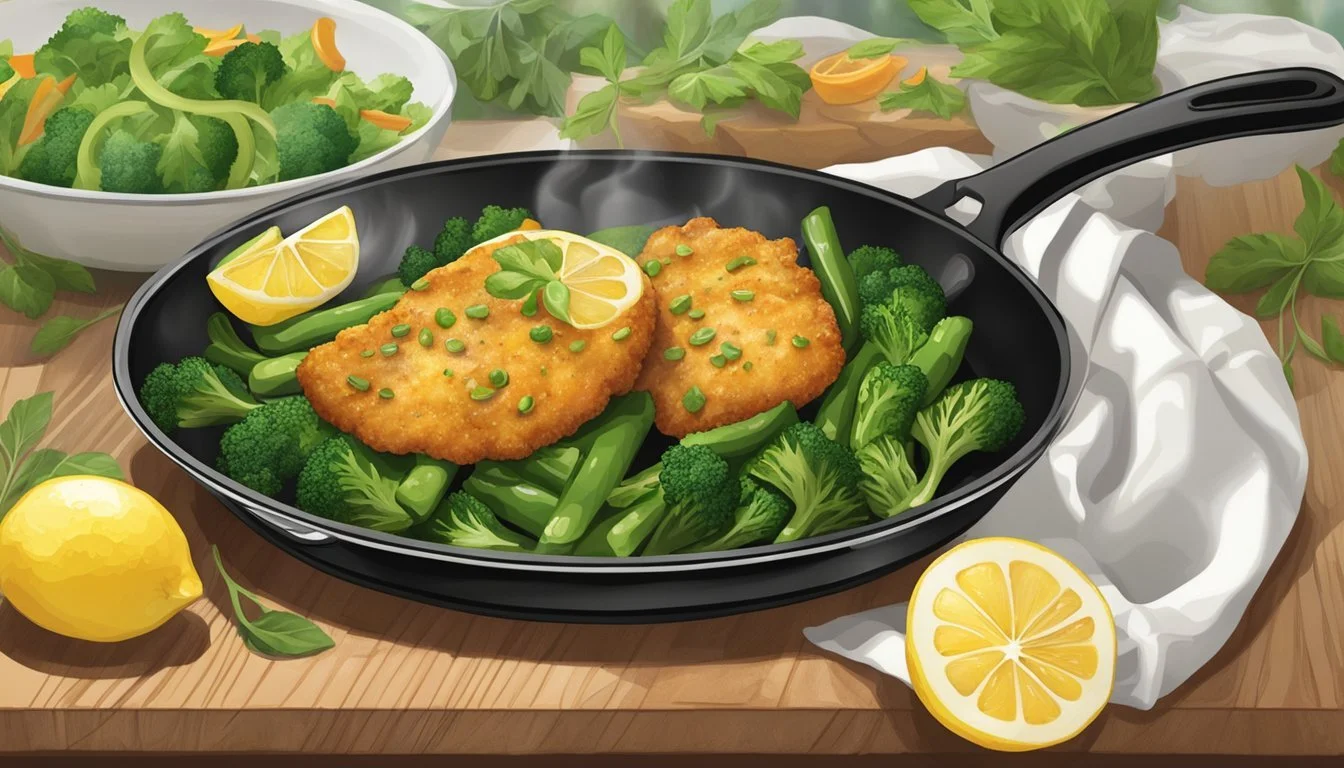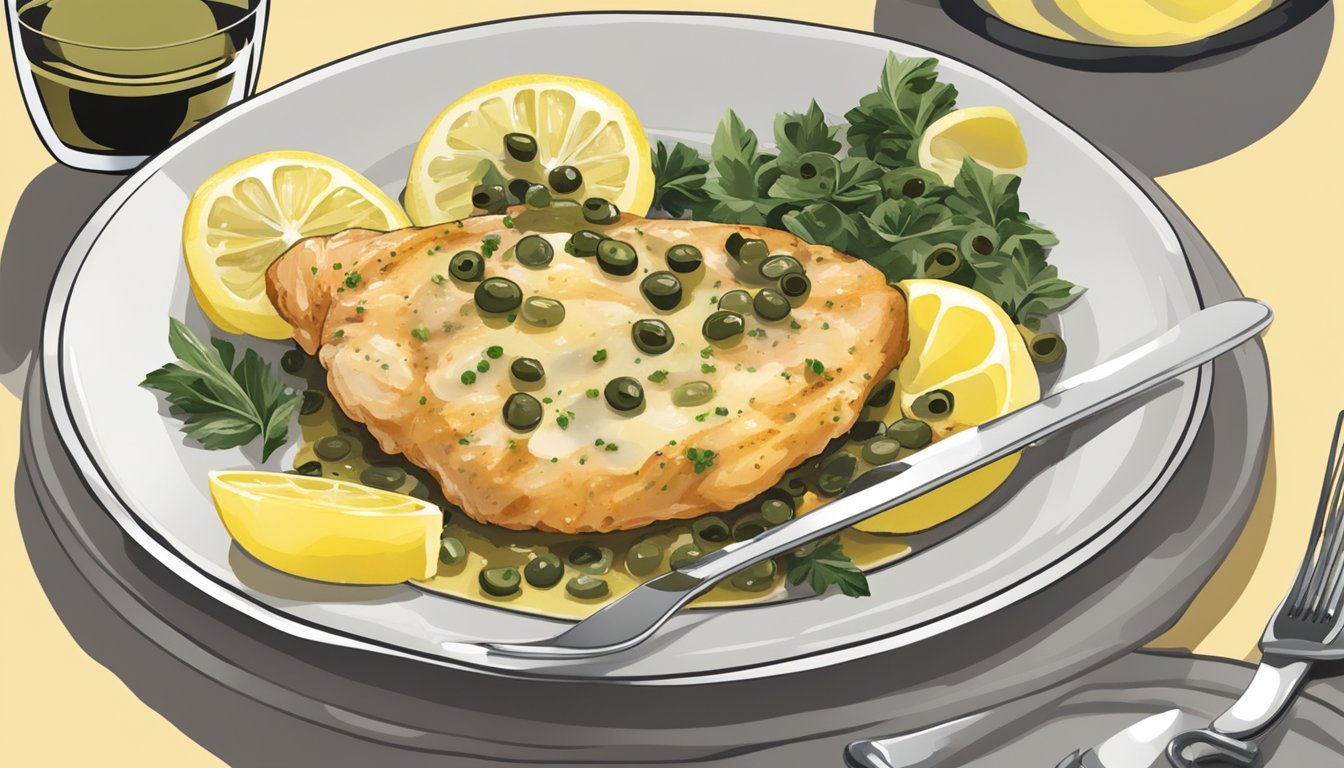Is Chicken Piccata Gluten-Free?
Understanding Its Ingredients and Preparation
Chicken Piccata (What wine goes well with chicken piccata?) is traditionally an Italian dish that offers a rich blend of flavors, thanks to its combination of lemon, capers, (What wine goes well with capers?) and a buttery sauce. The classic recipe typically involves dredging chicken cutlets in wheat flour before cooking, which poses a concern for those following a gluten-free diet. However, the good news for gluten-sensitive individuals is that Chicken Piccata can indeed be adapted to fit a gluten-free lifestyle without compromising on its signature taste.
The process of making Chicken Piccata gluten-free involves substituting wheat flour with alternatives such as arrowroot flour, gluten-free all-purpose flour, or even starches like potato or tapioca. These gluten-free options serve to thicken the sauce and provide the chicken with a desirable coating that browns nicely when sautéed. The rest of the recipe retains the traditional ingredients – chicken breasts (What wine goes well with chicken breast?), lemon, capers, and a combination of butter and oil – ensuring that the final dish remains authentic in flavor and appearance.
Adapting recipes to be gluten-free not only requires careful selection of alternative ingredients but also an awareness of cross-contamination risks in the kitchen. By making these adjustments, cooks can ensure that Chicken Piccata is safely enjoyed by those who adhere to a gluten-free diet without sacrificing the essence of this beloved dish.
Gluten-Free Essentials
In the pursuit of gluten-free cooking, including dishes like Chicken Piccata, it is essential to understand what constitutes a gluten-free diet, know how to create a gluten-free version of this classic dish, and select appropriate gluten-free ingredients.
Understanding Gluten-Free
Gluten-free refers to foods that do not contain gluten, a protein found in wheat, barley, rye, and triticale. For individuals with celiac disease or gluten sensitivities, consuming gluten can lead to health complications, thus necessitating a strict gluten-free diet. A gluten-free diet excludes traditional flours and pastas, and instead uses alternatives made from various grains and nuts that do not contain gluten.
Gluten-Free Chicken Piccata Overview
Chicken Piccata typically consists of chicken breast cutlets coated with flour, pan-fried, and served in a sauce containing lemon juice, capers, and sometimes wine or broth. A gluten-free Chicken Piccata adapts the traditional recipe by replacing wheat flour with gluten-free options, ensuring that the entire dish is safe for those avoiding gluten. Often, gluten-free flour blends or grain-free flours such as almond flour are used as the breading in this lighter, wheat-free version.
Selecting Gluten-Free Ingredients
When preparing gluten-free Chicken Piccata, carefully selecting gluten-free ingredients is key. Below is a brief guide to choosing safe options:
Flour for Dredging: Opt for gluten-free flour blends or single-ingredient flours such as almond flour or arrowroot flour. These not only provide the desired consistency but also enhance the flavor profile.
Pasta: If Chicken Piccata is to be served over pasta, select a gluten-free pasta made from rice, corn, quinoa, or a blend of gluten-free grains.
Remember, contamination with gluten-containing foods must be avoided, so always check labels for certification and keep gluten-free ingredients separate in the kitchen.
Preparing Chicken Piccata
Preparing Chicken Piccata involves a systematic approach to handling the chicken, creating a gluten-free dredging mixture, and using specific cooking techniques to ensure the dish remains gluten-free without compromising on the traditional Piccata flavors.
Chicken Cutlet Preparation
To start, one should use boneless skinless chicken breast. For an even cook, the chicken breast is typically butterflied and then pounded to an even thickness, which allows for quick and even cooking. The cutlets should be patted dry to ensure proper browning.
Creating the Dredging Mixture
For the dredging mixture:
Combine a gluten-free flour substitute, such as arrowroot, with spices like salt, pepper, and garlic powder in a shallow dish.
This mixture is used to coat the chicken cutlets. Each cutlet should be coated evenly and any excess flour should be shaken off to ensure a light breading.
Cooking Techniques
Chicken Piccata is traditionally cooked by pan-frying. To cook the cutlets:
Heat a combination of butter and olive oil in a skillet over medium to medium-high heat.
Once the fats are hot, add the dredged cutlets to the pan.
Pan-fry the chicken for approximately 3-4 minutes per side, or until each side is golden and the chicken is cooked through.
By following these steps with attention to detail, Chicken Piccata can be both delicious and gluten-free.
Sauce and Seasoning
The sauce and seasoning of a chicken piccata dish play crucial roles in defining its flavor profile. The traditional lemon caper sauce, enriched with butter and balanced with the right amount of salt and pepper, transforms the chicken into a zesty and savory delight. When creating a gluten-free variant, one must ensure that all elements comply with gluten-free standards, including the use of gluten-free stock.
Lemon Caper Sauce Creation
Ingredients:
Lemon juice
Capers
Butter (or dairy-free alternative)
Chicken stock (ensure it's gluten-free)
Olive oil
Salt and pepper
Prepare the skillet: Heat olive oil in a skillet over medium-high heat.
Combine the basics: Once hot, add the lemon juice and chicken stock to develop the base.
Incorporate capers: Stir in capers, allowing their piquant flavor to infuse the sauce.
Finish with butter: Melt butter into the sauce for a smooth and glossy finish.
Seasoning: Season with salt and pepper, adjusting to taste.
The key to a successful lemon caper sauce is a balance between the tartness of the lemon and the briny capers, offset by the rich smoothness of the butter.
Balancing Flavors
Taste as you go: Continuously taste the sauce and adjust the seasonings accordingly.
Acid and salt harmony: Ensure that the tanginess of lemon juice is well-balanced with salt; neither should overpower the other.
A chicken piccata's iconic taste hinges on the careful combination of the ingredients. The intertwining of the tartness from the lemon juice with the saltiness from the capers and the butter's richness requires a thoughtful approach to seasoning. Each component should complement the others, achieving a harmonious blend that will accentuate the chicken's flavor without overwhelming it. Fresh garnishes, such as parsley, can be sprinkled atop the dish before serving for added color and a subtle herbal freshness.
Health and Dietary Considerations
Chicken piccata traditionally includes ingredients such as flour and butter, which can present challenges for those with dietary restrictions. This section examines its nutritional content and explores allergen-free alternatives.
Calorie and Nutrient Content
Chicken piccata is typically moderate in calories, as the main ingredient is lean chicken breast. However, the calorie count can rise with the addition of flour and fats used in cooking. On average, a serving of chicken piccata contains approximately 300-400 calories, with variations depending on the preparation method. It is also a good source of protein but can vary in carbohydrates, fat, sodium, and cholesterol content.
Fat: The dish can contain a significant amount of fat, both saturated and unsaturated, due to oils and butter used in sautéing.
Carbohydrates: Chicken piccata coated with traditional flour will have a higher carbohydrate content, affecting those on a keto diet.
Sodium: Capers, used for flavor, can increase the dish's sodium levels.
Cholesterol and Saturated Fat: Presence depends on the cut of the chicken and the amount of butter or oil used.
Table: Nutrition Facts Snapshot per Serving
Nutrient Approximate Amount Calories 300-400 Protein (g) 20-30 Fat (g) 10-20 Saturated Fat (g) 3-5 Carbohydrates (g) 10-30 Fiber (g) 1-2 Sugar (g) 0-5 Sodium (mg) 500-800 Cholesterol (mg) 70-90
These numbers are estimates and can vary. For detailed nutrition facts, one should consult specific recipes or product labels.
Allergen-Free Alternatives
Gluten-Free Alternatives: Chicken piccata can be made gluten-free by substituting traditional flour with gluten-free options such as arrowroot flour, gluten-free blends, or starches like potato or tapioca.
Gluten-Free Flours: Provide a similar texture with fewer carbohydrates, making them suitable for a keto diet when used in moderation.
Dairy-Free Modifications: To cater to dairy-free diets, chefs can use alternatives like ghee, avocado oil, or olive oil instead of butter.
Healthy Fats: By using heart-healthy oils rich in monounsaturated fat, individuals can lower saturated fat content without sacrificing the dish's richness.
It's crucial to choose ingredients carefully to maintain the characteristic taste while adhering to health and dietary preferences.
Serving and Pairing
A well-paired and beautifully presented Chicken Piccata can elevate the dining experience. Selecting gluten-free sides that complement the flavors and presenting the dish with care are essential for a complete meal.
Choosing the Right Side Dishes
When serving Chicken Piccata, one must consider side dishes that harmonize with its tangy and rich flavors. Popular gluten-free options include:
Rice: A fluffy bed of rice can absorb the piccata sauce beautifully.
Cauliflower Rice: A low-carb alternative, great for soaking up flavors.
Mashed Potatoes: Creamy mashed potatoes provide a comforting balance to the piccata.
Roasted Vegetables: Vegetables like broccoli and green beans add a crunchy texture.
Zucchini Noodles: For a lighter, grain-free option, these noodles work well.
Spinach: Wilted or steamed, it pairs nicely with the chicken's zest.
One should ensure that all side dishes maintain the integrity of being gluten-free, complementing the lighter nature of Chicken Piccata without overwhelming it.
Presentation Tips
The presentation of Chicken Piccata with its accompaniments should be as thoughtful as the cooking process.
Plates: Opt for plain, white dishes that make the colors of the food stand out.
Arrangement: Place the chicken as the centerpiece with sides neatly arranged around it.
Garnishes: Use lemon slices, fresh herbs, or capers for an elegant finish.
It is important that the presentation highlights the freshness and vibrant colors of the Piccata and its sides, creating an inviting and appetizing dish.
Recipe Variations and Ideas
When making Chicken Piccata, which is traditionally an Italian dish, one can explore various regional adaptations, simplify the process for a quick meal, or add creative twists for special occasions. Each variant maintains the essence of the classic dish while offering unique flavors or textures.
Exploring Regional Variants
Italian cuisine is rich with regional recipes that make it exciting to experiment with Chicken Piccata. One could integrate elements from Chicken Parmesan (What wine goes well with chicken parmesan?), using gluten-free breadcrumbs for a crispy coating, or borrow the earthy mushroom flavors from Chicken Marsala (What wine goes well with chicken marsala?) by adding sautéed mushrooms to the Piccata sauce.
Quick and Easy AdaptationsWhat wine goes well with chicken marsala?
For those seeking a simplified version suitable for a weeknight meal, the traditional Chicken Piccata can be adapted to fit into a busy schedule. Use thin chicken cutlets for faster cooking, and prepare the lemon-caper sauce in the same pan to reduce cleanup. A simple Chicken Piccata can be on the table in as little as 20 minutes.
Creative Twists for Special Occasions
To elevate Chicken Piccata for a date night or family gathering, one can add luxury with artichoke hearts or sun-dried tomatoes. Pair with gluten-free pasta or a bed of steamed vegetables for a more impressive dish. The key to a special occasion Chicken Piccata lies in the presentation and the pairing of bold, complementary flavors.
Cooking and Safety Tips
When preparing Chicken Piccata, especially gluten-free versions, understanding the correct cooking time and temperature, along with using the appropriate equipment, is crucial for both safety and flavor.
Achieving the Perfect Cook Time and Temperature
The secret to perfectly cooked Chicken Piccata lies in reaching the safe internal temperature while maintaining tenderness. For chicken, the safe internal temperature is 165°F (74°C), which can be verified with a meat thermometer. The process typically involves:
Using a meat mallet, gently pound the chicken breast cutlets to an even thickness. This helps in even cooking and reduces cook time.
Cook chicken in a preheated skillet or frying pan over medium-high heat. Generally, each side requires about 3-4 minutes until golden brown.
Cooking Equipment Essentials
Utilizing the right tools is another vital aspect of cooking.
Frying Pan or Skillet: Preferably non-stick, must be suitable for medium-high heat.
Meat Mallet: Essential for flattening the chicken to ensure even cooking.
Meat Thermometer: Mandatory for checking the internal temperature to ensure the chicken is safe to eat.
Proper equipment ensures the cook's safety and enhances the overall dish quality, preserving the gluten-free integrity of the meal. Use equipment that has not been previously used to cook gluten-containing foods to prevent cross-contamination.
Final Thoughts
In considering whether chicken piccata can be gluten-free, it is important to examine the preparation method and ingredients utilized to ensure they meet gluten-free standards.
Summary of Key Points
Flavor: The quintessential taste of chicken piccata is retained by using gluten-free alternatives such as arrowroot flour or almond flour for dredging the chicken, maintaining its savory appeal.
Crispy Texture: Achieving the desirable crispiness is possible with gluten-free flour, ensuring the chicken maintains its classic texture when pan-fried in oil or butter.
Garnish: Capers and lemon are common garnishes for chicken piccata that naturally contain no gluten, adding both flavor and acidity to the dish.
Health Considerations: Gluten-free chicken piccata offers a delicious option for those with celiac disease or gluten sensitivity. However, as with all dishes, the overall healthiness depends on the cooking methods and portion sizes.







